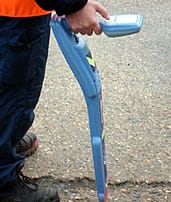Radiodetection is the manufacturer of a series of radio detection devices for locating and mapping underground cables and pipes. They are used in more than 60 countries for the purpose of avoiding cables and pipes when a contractor has to excavate soil in any location. Who knows what might be down there – and more importantly exactly where it is located – before we start to dig? It would also be helpful to know just how deep a cable or pipe is. Damaging buried utilities can not only be extremely dangerous to operatives working on the ground, but it can also be very expensive.
The RD8100 range of precision locators is designed to be used to pinpoint accurately a range of different cables and pipes in a variety of locations. These professional instruments represent the culmination of Radiodetection’s experience in the design and manufacture of locators.
However, using the RD8100 locators is not simply a matter of taking them out of the box and “off we go!” Learning how to use them takes time and practice in a number of different situations. Imagine never having seen a car before. You can’t just sit in the driver’s seat and drive. You need training in what and where all the gadgets are, what they do, how they do it, and how to use them. The same thing applies to the RD8100 range.
Read More Original Content at Radiodetection RD8100 training
